

It has not been a big secret hereabouts that I'm a
Lovecraft fan. That state of being condemns one to a peculiar pocket
of film-going: just as you know there is no way in hell the cosmic
creepiness oozing from the page can ever be successfully translated
to the screen, you still find yourself watching every attempt, just
in case. Just in case.
 The
way I feel about Lovecraft is probably due to the way I first encountered
him. I was a sickly child, and couldn't participate in the usual
rough-and-tumble children's play. Not surprisingly then, I read
a lot. I had tunneled through everything Jules Verne and H.G. Wells
had to offer by the time I was 10; I had discovered them through
the then-ubiquitous Classics Illustrated comic books. You could
generally find me, on a summer's day, in the public library: I was
the little guy in the big person's section. There wasn't much in
the youth section that interested me.
The
way I feel about Lovecraft is probably due to the way I first encountered
him. I was a sickly child, and couldn't participate in the usual
rough-and-tumble children's play. Not surprisingly then, I read
a lot. I had tunneled through everything Jules Verne and H.G. Wells
had to offer by the time I was 10; I had discovered them through
the then-ubiquitous Classics Illustrated comic books. You could
generally find me, on a summer's day, in the public library: I was
the little guy in the big person's section. There wasn't much in
the youth section that interested me.
No, that adult section held Ray Bradbury, H. Hunter
Holly, and the Alfred Hitchcock anthologies. And there was one thick
gray book that held a simple legend on its spine: A SCIENCE FICTION
OMNIBUS. This was paydirt. This was a worthy investment in time.
The book held a treasure trove of stories I had never read before,
and many I haven't seen since. A few have stayed with me, through
the years. Most have not.
And one of the stories, sandwiched in between tales
of experiments gone awry and the unforeseen consequences of progress,
was "The Colour Out of Space". Though it seemed lengthier
than most of the others, I settled down to read it late one night.
Big mistake. Not reading it; reading it late at
night.
I can look back on that terrified little boy contemplating
the walk down a darkened hallway to an equally dark bathroom with
some bemusement and not a little pang of regret: ah, lad, how
I envy you the ability to have mere words on a page affect you so.
Well, I was sold on this Lovecraft guy, but in those
days, his work was a little harder to come by. In an incredible
anthology called Sleep No More (illustrated by Hannes Bok!),
I found "The Rats in the Walls". Then a book from Scholastic
Press, of all places, contained "The Dunwich Horror".
Then paperback reprints began coming out again, and I tracked each
and every one of them down.
Inevitably, one night, Project:Terror showed
Die, Monster, Die!, and even at that young age, I was prepared
for the 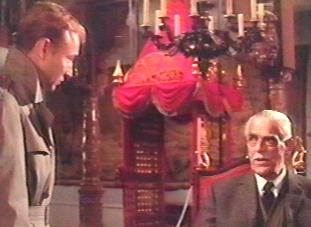 worst.
I knew the movie was based on my inaugural Lovecraft experience,
but also had a feeling that, since they had changed the title, they
had surely changed a lot more. I may have been sickly, but I was
working on a brain I fancied to be like Victor Von Doom's.
worst.
I knew the movie was based on my inaugural Lovecraft experience,
but also had a feeling that, since they had changed the title, they
had surely changed a lot more. I may have been sickly, but I was
working on a brain I fancied to be like Victor Von Doom's.
I mentioned in our examination of The
Dunwich Horror most of the AIP attempts at Lovecraft took
Corman's Poe films as a template for adapting weird literature to
the screen, with the central device of an outsider arriving at a
decrepit, antiquated house that contains, ooooooooo! Secrets!
Die, Monster, Die takes this so to heart, it almost forgets
to put some Lovecraft into the mix.
The Outsider in this case is American Stephen Rinehart
(Nick Adams), who arrives in the rural English hamlet of Arkham,
only to find that everyone there immediately gives him the cold
shoulder once they find out he is traveling to the Whitley place.
Okay, so this part isn't really cribbed from the Poe flicks, it's
more like the Dracula pictures - the villagers do everything but
hiss, "Nosferatu!" before they scamper away. Unable
to even rent a bicycle, Rinehart is forced to walk to the Whitley
estate. Along the way, he passes increasingly blighted and brittle
vegetation, and a large crater.
Rinehart eventually finds the eternally fog-enshrouded
Whitley house - the gates are locked, and the one breach in the
wall surrounding the manse contains a bear trap. Being a bull-headed
American, Rinehart finally makes it into the house, only to be rebuffed
by Nahum (Boris Karloff), the wheelchair-bound patriarch of the
family, who first insists that he leave, but once his lovely daughter
Susan(Suzan Farmer) discovers her college buddy (and lover) has
arrived, Nahum's protestations fade into the background.
Especially when Rinehart meets with Nahum's wife,
Letitia (Freda Jackson), who's the one who actually sent for the
American. She tells him weird things have been going on, culminating
in the disappearance of their maid, Helga. Letitia is also f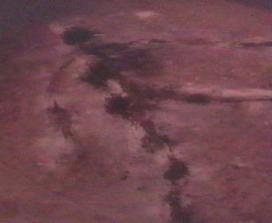 alling
prey to some bizarre wasting disease which also makes her sensitive
to light; she spends all her time in her darkened bedroom, her bed
surrounded by thick netting. She asks Rinehart to take Susan away,
and to that end, he agrees to stay for a while(?).
alling
prey to some bizarre wasting disease which also makes her sensitive
to light; she spends all her time in her darkened bedroom, her bed
surrounded by thick netting. She asks Rinehart to take Susan away,
and to that end, he agrees to stay for a while(?).
At an uncomfortably silent dinner that evening, Rinehart
asks about the Blasted Heath outside the mansion, and is answered,
"There was a fire." Similarly, an odd howling outside
the house is pointedly ignored. The butler, Merwyn (Terrance de
Marney), who has been none too steady, collapses. Nahum insists
he knows how to care for him. Later that night, while investigating
odd howls inside the house, Rinehart is told by Nahum that
Merwyn has perished.
Ignoring Nahum's order to retire for the night, Rinehart
sees the old man wheel a trunk outside in his own wheelchair. In
Merwyn's room, he finds the bloody outline of a human body. Outside,
he watches Nahum bury the trunk. He also discovers 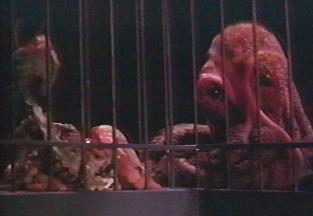 the
greenhouse is locked, despite the eerie green glow within...
the
greenhouse is locked, despite the eerie green glow within...
Susan helpfully remembers a way into the greenhouse
she used as a child, when she wanted to hide. Inside, she and Rinehart
find plants grown outlandishly large. The aforementioned strange
howling is coming from the potting shed, which has been converted
into a "zoo in hell", where mutated animals bathe in the
light of some strangely glowing rocks. Rinehart finds shards of
the same rock buried in each plant's soil; the radiation from these
fragments is causing the plant's growth while at the same time killing
them, as evidenced by the smell of decay permeating the greenhouse.
Susan is attacked by an animate vine, and she and Rinehart make
a hasty exit through a door he smashes through.
Rinehart finds that the crater outside was caused
by a meteorite, 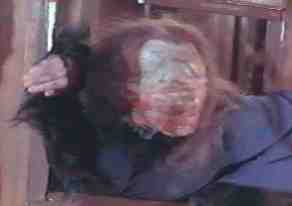 which
Nahum dragged into the cellar. He has been experimenting with the
effects of its radiation upon plants and animals; unfortunately,
Helga and Letitia worked in the greenhouse constantly. Helga has
gone insane and is lurking about the grounds, wearing a black funeral
outfit, complete with veil (and butcher knife!), and Letitia trashes
her room and vanishes during the requisite thunderstorm.
which
Nahum dragged into the cellar. He has been experimenting with the
effects of its radiation upon plants and animals; unfortunately,
Helga and Letitia worked in the greenhouse constantly. Helga has
gone insane and is lurking about the grounds, wearing a black funeral
outfit, complete with veil (and butcher knife!), and Letitia trashes
her room and vanishes during the requisite thunderstorm.
After searching for the missing matriarch for a bit,
Letitia is found, but the radiation has made her go all lumpy and
homicidal. After a short chase and a bashed-through door, Letitia
misses a rush at Rinehart and stumbles out into the rain. For some
reason, the radiation has made her water-soluble, and she dissolves
into a gooey mess.
This leads to a moment of clarity on Nahum's part
- he begs Rinehart to take Susan away while he destroys the meteorite.
The elderly man manages to get in one good whack with a battleaxe
before he is interrupted by the murderous Helga. They struggle,
with the result that 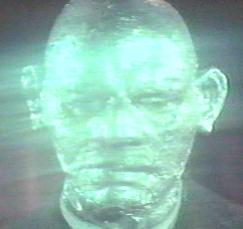 they
fall onto the shattered meteor. Helga is destroyed, but Nahum
changes into a silvery glowing agile dude with ears that stick out
farther than Jeremy Brett's. After a semi-exciting fight scene (and
another smashed door), Nahum falls from the second floor balcony
and shatters. The radiation from his body sets the carpet afire,
resulting in the requisite fiery end for the Old Dark House. The
end.
they
fall onto the shattered meteor. Helga is destroyed, but Nahum
changes into a silvery glowing agile dude with ears that stick out
farther than Jeremy Brett's. After a semi-exciting fight scene (and
another smashed door), Nahum falls from the second floor balcony
and shatters. The radiation from his body sets the carpet afire,
resulting in the requisite fiery end for the Old Dark House. The
end.
As I said earlier, Die, Monster, Die! relies
quite heavily on the Gothic clichés to pad out its running
length. When Rinehart makes his clandestine journey down to the
cellar to find out What's At The Bottom Of All This, he may not
run into the usual jump-out-and-go-boo device, the Spring-Loaded
Cat™ (aside: thank you, Jabootu),
but he will encounter The Skeleton Behind A Door For No Good
Reason, and the terrible Bat On A String™ (My wife is particularly
afraid of the Bat On A String™) . Also in attendance is another
standard, the 300-Watt Candle®.
After a while, it seems, somebody
seems to realize that this is supposed to be based on a Lovecraft
story, so they throw fans of the old fellow a few bones, here and
there. Aside from Arkham , inexplicably translocated to England
(well, perhaps not so inexplicable - shooting at Shepperton Studios
was doubtless cheaper than shooting in Hollywood*) (at
least doors are cheaper - no fewer than three are smashed
though by various characters. You almost expect to see Suzan Farmer
smash through one, just because she's the only major character who
hasn't gotten to, yet) (Crap! Where was I?), we have a strange 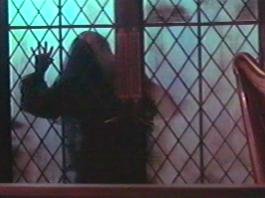 bulltwaddle
backstory involving Nahum's father, Corbin, who is generally passed
off as having "gone insane" after dabbling in some heavy-duty
diabolism. Heavy-duty as in "The Great Outer Ones". Letitia
(and a sadder, wiser Nahum, by the end) blame Corbin and his demons
for the arrival of the meteorite. A final fade to Corbin's portrait,
burning in the climactic conflagration, seems to bear this theory
out. Yeah. Whatever.
bulltwaddle
backstory involving Nahum's father, Corbin, who is generally passed
off as having "gone insane" after dabbling in some heavy-duty
diabolism. Heavy-duty as in "The Great Outer Ones". Letitia
(and a sadder, wiser Nahum, by the end) blame Corbin and his demons
for the arrival of the meteorite. A final fade to Corbin's portrait,
burning in the climactic conflagration, seems to bear this theory
out. Yeah. Whatever.
Past that, I seem to recall the story taking place
on a backwater farm, not an English estate, nor did the inhabitants
experiment with the meteor (didn't they drop it down a well?). Once
again, the filmmakers did not trust the source material sufficiently
to even attempt to meet it on its own terms; instead, they remade
a hundred other movies and took the central device, the MacGuffin,
the Bear, and slipped it in under cover of that constant fog.
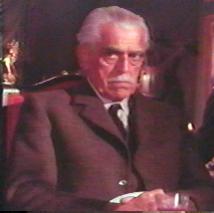 The
picture also relies heavily on the fact that its villain is, after
all, B*O*R*I*S K*A*R*L*O*F*F*. Frail and ailing, the horror legend
really was confined to a wheelchair at this point in his life, which
makes it awfully hard to project an aura of menace. Instead, the
picture opts for a misguided, single-minded antagonist who lets
his vaunted "purpose" blind him to the harm he is doing
to all about him. When you see Karloff rise from his chair to feebly
dig at the ground because he must bury the trunk concealing
his dismembered manservant, or to single-handedly destroy his radioactive
discovery, you feel not only the driven quality of the character,
but more than a little admiration for the actor. Karloff acted right
up until his death in 1969, rising from his wheelchair, hitting
his mark, saying his lines, and then collapsing back into the chair.
The
picture also relies heavily on the fact that its villain is, after
all, B*O*R*I*S K*A*R*L*O*F*F*. Frail and ailing, the horror legend
really was confined to a wheelchair at this point in his life, which
makes it awfully hard to project an aura of menace. Instead, the
picture opts for a misguided, single-minded antagonist who lets
his vaunted "purpose" blind him to the harm he is doing
to all about him. When you see Karloff rise from his chair to feebly
dig at the ground because he must bury the trunk concealing
his dismembered manservant, or to single-handedly destroy his radioactive
discovery, you feel not only the driven quality of the character,
but more than a little admiration for the actor. Karloff acted right
up until his death in 1969, rising from his wheelchair, hitting
his mark, saying his lines, and then collapsing back into the chair.
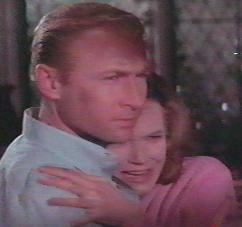 Nick
Adams appeared in this before what could be called his career's
slide into oblivion. The next stop after this was a trio of Japanese
films, including Frankenstein Conquers the World and Godzilla
vs. Monster Zero, then Mission Mars, a space exploration
movie made in '68 and felt like it, to a final, fatal overdose
in '69. As Rinehart, Adams is called upon to do little more than
be American, i.e., loud and angry most of the time.
Nick
Adams appeared in this before what could be called his career's
slide into oblivion. The next stop after this was a trio of Japanese
films, including Frankenstein Conquers the World and Godzilla
vs. Monster Zero, then Mission Mars, a space exploration
movie made in '68 and felt like it, to a final, fatal overdose
in '69. As Rinehart, Adams is called upon to do little more than
be American, i.e., loud and angry most of the time.
Director Daniel Haller would attempt Lovecraft again,
five years later, with The
Dunwich Horror, which deviates even farther from its basis,
with even worse results. Then again, another attempt was made to
bring "The Colour Out of Space" to screen with a somewhat
more faithful adaptation, called The Curse, a movie which
is spoken of in terms usually reserved for serial killers, tax collectors,
or....well, Wesley Crusher. Even I am loathe to watch this
movie. So much for keeping faith with the source material.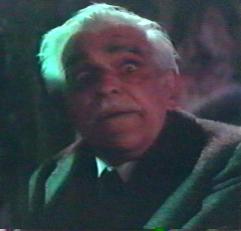
It's interesting to note that probably the most successful
Lovecraft movie to date - Re-Animator - was based on the
least of the author's works, which even he did not like,
a series of short shorts that had no chance to construct or establish
the mood Lovecraft did so well. Film is a visual art, and at his
best, Lovecraft either kept his boogey men in the dark, or they
were so monstrous that upon seeing them, the narrator was driven
mad. So perhaps it is a good thing that a truly successful
Lovecraft movie has never been made.